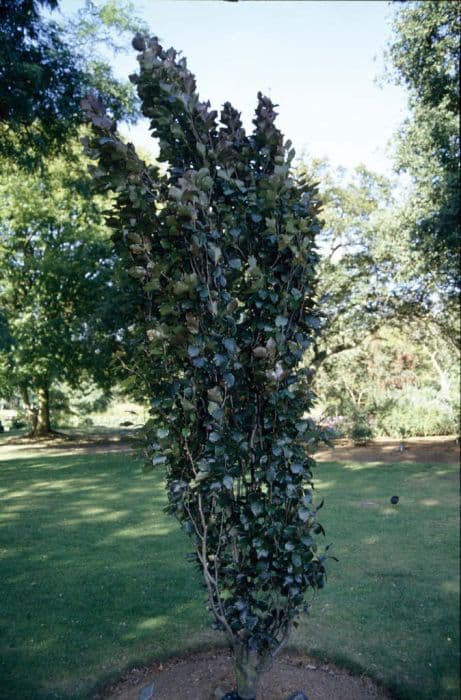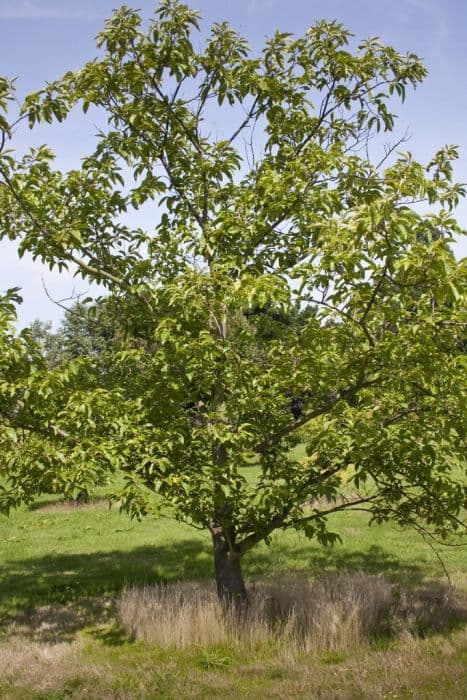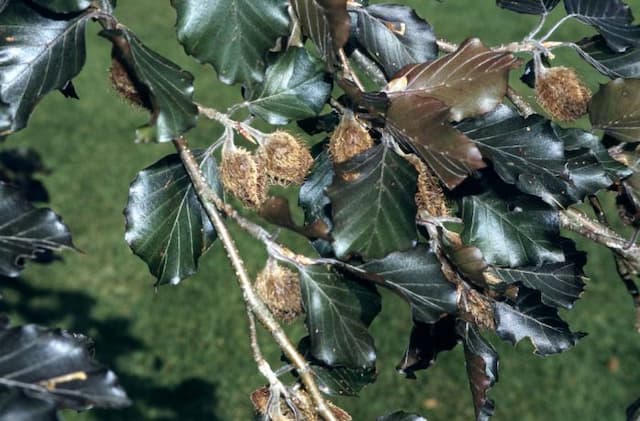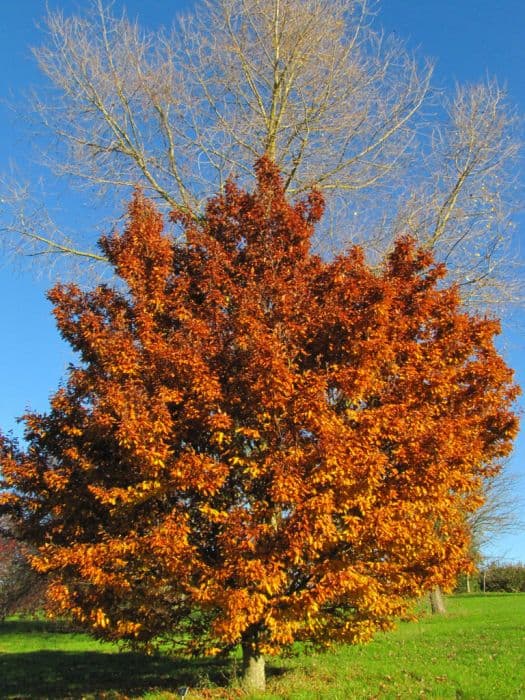Fernleaf Beech Fagus sylvatica var. heterophylla 'Aspleniifolia'

ABOUT
The European beech with the cultivar name 'Aspleniifolia', commonly known as the fernleaf beech, is a unique and visually striking variety. The name "fernleaf" hints at the plant's most distinctive feature: its finely cut leaves. Unlike the broad, oval leaves of the typical European beech, this cultivar's leaves are deeply serrated or incised, resembling the graceful fronds of a fern. This gives the foliage a delicate, airy texture, quite different from the solid canopy commonly associated with beech trees. The fernleaf beech is adorned with a rich, green color during the spring and summer months. Each leaf is slender and intricately detailed, which can create a mesmerizing pattern when viewed up close. As the seasons change, the foliage undergoes a dramatic transformation, taking on shades of golden yellow or copper, adding a touch of warm color to the landscape before falling off in the autumn. The bark of the fernleaf beech is another elegant aspect, typically smooth and silvery gray, providing a striking contrast to its finely cut foliage. This can make the tree particularly attractive in winter, as the bark stands out against snowy backgrounds. Additionally, the overall shape of the fernleaf beech can be quite beautiful. The way the branches spread and intertwine adds to the complexity and ornamental value of this tree. In essence, with its unique leaf structure, seasonal color changes, and contrasting bark, the fernleaf beech is a specimen that can create visual interest in a garden or landscape throughout the year.
About this plant
 Names
NamesSynonyms
Fernleaf Beech, Cut-leaved European Beech, Fern-leaved Beech, Asplenifolia Beech
Common names
Fagus sylvatica f. heterophylla 'Aspleniifolia', Fagus sylvatica 'Laciniata', Fagus sylvatica 'Asplenifolia'.
 Characteristics
CharacteristicsLife cycle
Perennials
Foliage type
Deciduous
Color of leaves
Green
Height
50-70 feet (15-21 meters)
Spread
35-45 feet (11-14 meters)
Plant type
Tree
Hardiness zones
4-7
Native area
Europe
Benefits
 General Benefits
General Benefits- Ecosystem Support: Provides food and habitat for various wildlife, including birds and insects.
- Aesthetic Appeal: Adds visual interest to landscapes with its unique fern-like foliage and graceful form.
- Shade Provider: Creates a cool, shaded area underneath, useful for outdoor activities and underplanting with shade-tolerant species.
- Privacy Screen: Dense growth habit makes it an excellent choice for creating a natural privacy screen or windbreak.
- Seasonal Interest: Offers year-round interest with its deep green leaves, turning to yellow and brown in the fall.
- Soil Improvement: Leaf litter from the tree decomposes, adding organic matter and nutrients back into the soil.
- Carbon Sequestration: Like all trees, helps to capture atmospheric carbon dioxide, mitigating climate change impacts.
 Medical Properties
Medical PropertiesThis plant is not used for medical purposes.
 Air-purifying Qualities
Air-purifying QualitiesThis plant is not specifically known for air purifying qualities.
 Other Uses
Other Uses- Beekeeping: The European beech variety, including Fagus sylvatica 'Aspleniifolia', produces abundant flowers that yield pollen, serving as a food source for bees in the production of honey.
- Woodworking: Its wood is workable and durable, making it suitable for creating decorative veneers, fine furniture, and intricate carvings within woodworking projects.
- Musical Instruments: Wood from the European beech can be used to make certain parts of musical instruments, such as the backs of violins and other stringed instruments, because of its acoustic properties.
- Culinary Smoking: The wood chips of European beech can be used for smoking meats and cheeses, imparting a mild, slightly sweet flavor to the smoked products.
- Dye Production: The bark and leaves of 'Aspleniifolia' can be used to produce natural dyes for textiles, giving shades of yellow, green, or gray depending on the mordant used.
- Education and Research: This plant, being a cultivar with unique foliage, is used in botanical gardens and arboreta for educational purposes, to teach about plant variation and cultivar development.
- Photography & Art: The distinct fern-like leaves of 'Aspleniifolia' offer a unique aesthetic that can be used as subjects or backdrops in photography and botanical illustrations.
- Architectural Modeling: Due to its fine-grained texture, the wood of the European beech can be used in architectural modeling, facilitating the creation of precise and detailed scale models.
- Wildlife Shelter: The dense canopy of Fagus sylvatica 'Aspleniifolia' provides habitat and shelter for various species of birds and other fauna within its growing range.
- Leaf Litter for Composting: The fallen leaves of 'Aspleniifolia' can be collected and used to create a rich leaf mold for composting, benefiting garden soil structure and fertility.
Interesting Facts
 Feng Shui
Feng ShuiThe European Fernleaf Beech is not used in Feng Shui practice.
 Zodiac Sign Compitability
Zodiac Sign CompitabilityThe European Fernleaf Beech is not used in astrology practice.
 Plant Symbolism
Plant Symbolism- Persistence: The European beech, with its hardy nature and resilience, is often associated with persistence, representing our ability to withstand challenges over time.
- Wisdom: European beeches can live for centuries, which has led to their symbolic connection with wisdom and knowledge, much like the ancient and storied forests they comprise.
- Longevity: The long lifespan of the European beech is emblematic of life, continuity, and the passage of time, often used to symbolize enduring presence.
- Stability: With their strong roots and sturdy trunks, beech trees represent stability and support, suggesting a grounding force in one’s life.
- Prosperity: The tree's abundant nut production in the past provided valuable food for wildlife and humans, which is why it can symbolize prosperity and sustenance.
- Enlightenment: Beech trees have a historical connection to ancient script and learning, as beech bark was used for early writing tablets, linking the tree to enlightenment and intellect.
 Water
WaterFor the European Fernleaf Beech, proper watering is essential to maintain its health. Water the tree deeply and slowly to encourage root growth, aiming for the water to penetrate several inches into the soil. Young trees should be watered once a week with about 10 gallons of water, especially during dry spells. As the tree matures, watering can be reduced to every two to three weeks, depending on the weather conditions. Always check the soil moisture level before watering to prevent overwatering, which can lead to root rot.
 Light
LightThe European Fernleaf Beech thrives in full sun to partial shade conditions. It is best to plant it in a spot where it can receive at least four to six hours of direct sunlight daily. Adequate light is necessary for the tree to develop its characteristic foliage and maintain a healthy growth pattern.
 Temperature
TemperatureThe ideal temperature range for the European Fernleaf Beech is between 35°F and 75°F. It can withstand temperatures as low as -20°F and as high as 90°F, but extreme temperatures may stress the plant. For optimal health and growth, this beech variety prefers moderate climates without prolonged periods of high heat or severe frost.
 Pruning
PruningPruning the European Fernleaf Beech should be done to remove dead or damaged branches, to shape the tree, and to improve its overall structure. The best time for pruning is in late winter or early spring before new leaves emerge. Prune selectively to maintain the tree's natural form, removing no more than a quarter of the crown at a time. Avoid heavy pruning and follow proper techniques to ensure the health of the tree and to enhance its ornamental appearance.
 Cleaning
CleaningAs needed
 Soil
SoilThe European Fernleaf Beech (Fagus sylvatica var. heterophylla 'Aspleniifolia') thrives best in well-drained but moist, fertile soil, with a mix of loam, organic matter, and a small amount of sand to improve drainage. The ideal soil pH for this tree is slightly acidic to neutral, ranging between 5.5 and 7.0.
 Repotting
RepottingThe European Fernleaf Beech seldom needs repotting as it's typically grown outdoors. However, young trees can be replanted every few years during their early growth phase or if they are being grown in a very large container, ensuring they are provided with fresh soil and more space to expand their root systems.
 Humidity & Misting
Humidity & MistingThe European Fernleaf Beech requires an environment that mimics its natural habitat, which means moderate to high humidity levels are preferable, to maintain its health and appearance.
 Suitable locations
Suitable locationsIndoor
Not suitable for indoor growth due to size.
Outdoor
Full sun to partial shade, tolerates a range of soil types.
Hardiness zone
4-7 USDA
 Life cycle
Life cycleFagus sylvatica var. heterophylla 'Aspleniifolia', commonly known as the fern-leaved European beech, begins its life as a seed, which under favorable conditions germinates in the spring following a period of cold stratification. The seedling develops a root system and a shoot that will grow into a trunk, with the first leaves adapting the characteristic fern-like appearance. Through the juvenile stage, the sapling will grow steadily, dependent on adequate light, water, and soil fertility. After several years, the tree reaches maturity, developing a broad, spreading canopy and starting to produce its own fruit – small triangular nuts encased in prickly husks. Pollination is typically by wind, and viable seeds are then dispersed by gravity or animal vectors to initiate new life cycles. This beech can live for centuries, during which time it may undergo periodic growth, reproduction, and eventual senescence, where growth slows and the tree becomes more susceptible to environmental stress and diseases until it dies.
 Propogation
PropogationPropogation time
Late winter
Fagus sylvatica var. heterophylla 'Aspleniifolia', commonly known as Fernleaf European Beech, is typically propagated through grafting. This technique involves joining a scion, which is a piece of a mature plant that you wish to clone, with a rootstock, a seedling or young plant that provides the root system. Grafting is often done in late winter or early spring, when the plant is still dormant. For successful grafting of Fernleaf European Beech, a scion with several buds is cut from a healthy, disease-free branch, ensuring a smooth, diagonal cut. The rootstock is similarly cut, and the two are joined so that the vascular cambium of both the scion and rootstock align. The graft joint is then bound with grafting tape and sealed with wax or a similar substance to prevent drying out. The grafted plant is then kept under appropriate conditions to ensure the scion successfully fuses with the rootstock and starts to grow.









